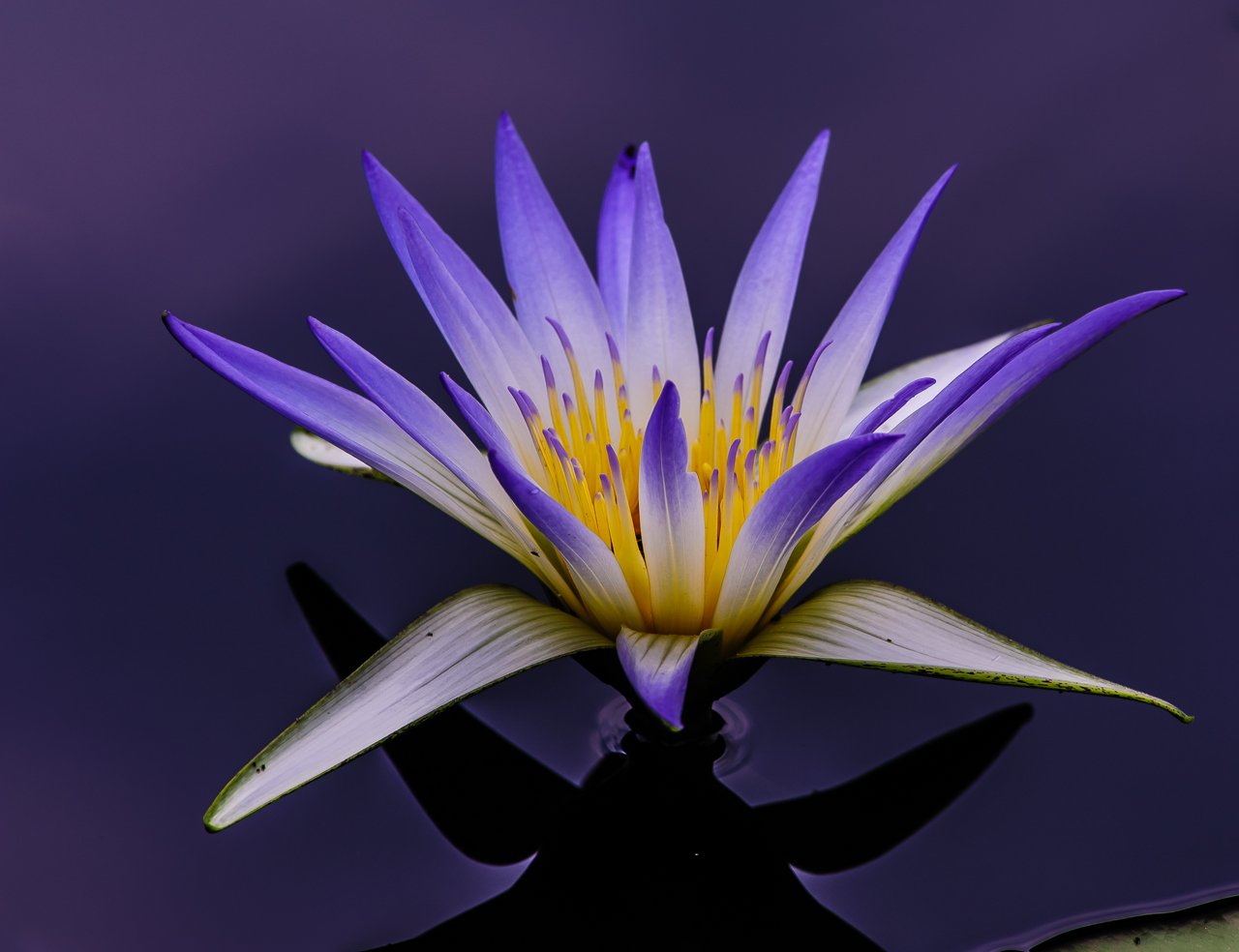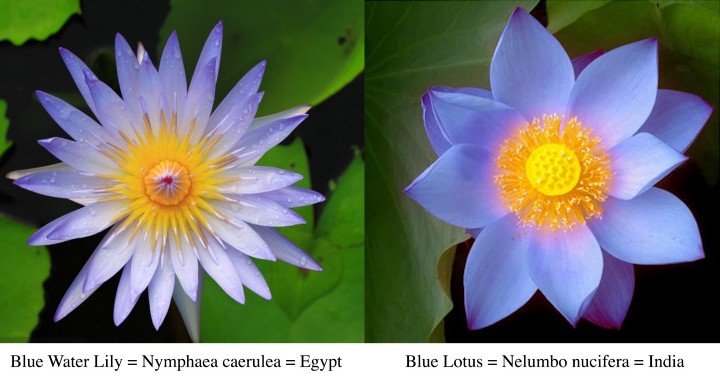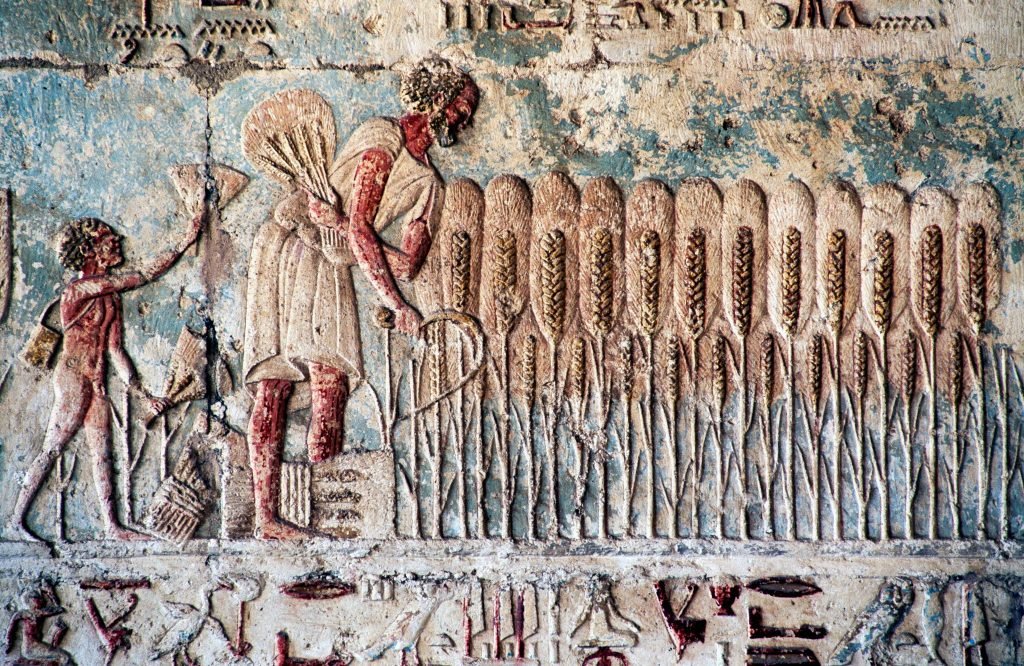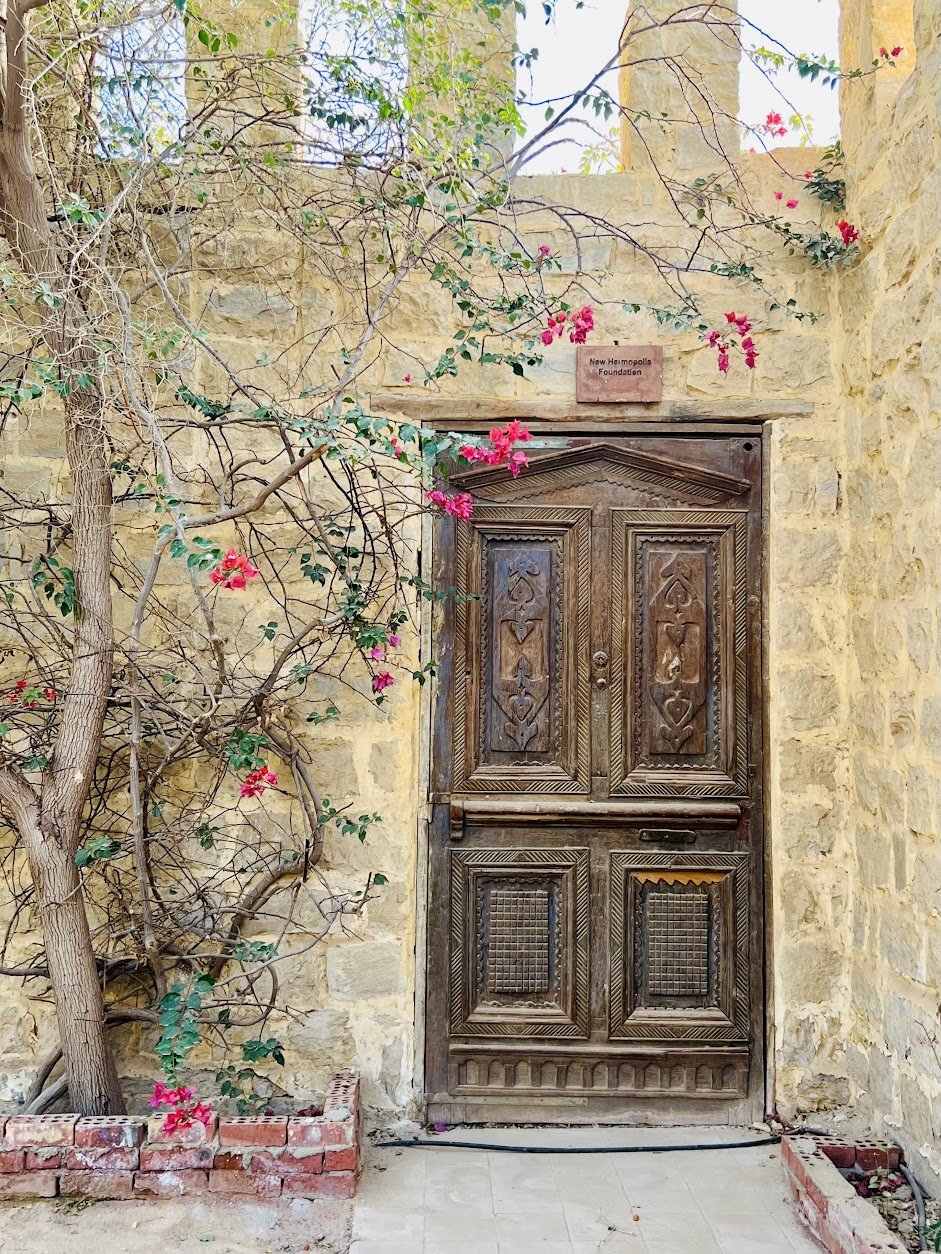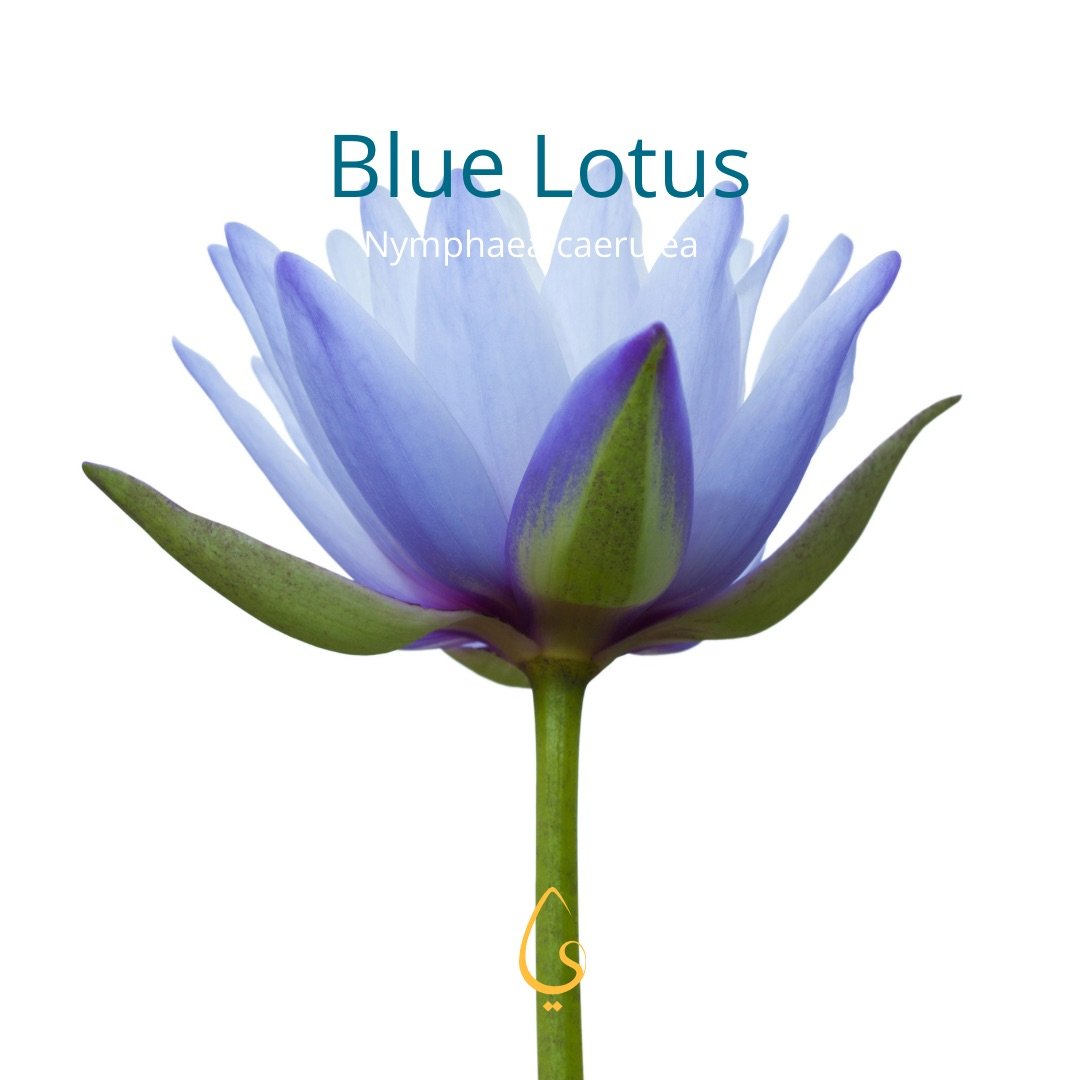Egyptian Blue Lotus, a flower of mythical roots
By Yasmine ElGhamrawy
A flower of mythical origins
The Egyptian blue lotus flower has mythical roots in the creation story itself. It is the story of continuous rebirth and renewal.
When observed over time, the Egyptians noticed that even though the lotus flower grew on muddy water banks of the river Nile, it would burst into bloom at sunrise every day, only to close up and dip underwater later at night. This cycle would continue for several days before it perishes, then a new bud would emerge to continue the cycle once more. Temple priests connected this cycle to the myth of creation. The creation god was born in the womb of a lotus flower which sprouted from Nun, the first water. His tears created humanity, and he was closely related to the sun god RA. the myth also talks about “healing” Ra with the “sacred blue lotus.”
Blue Lotus
Nymphaea caerulea
In ancient Egypt, men and women are seen frequently smelling the lotus flower and adorning their clothes and body with its petals. The Egyptian blue lotus was the most popular scented flower in ancient Egypt and had a deep spiritual connection to daily life. Its depictions are seen all over temple walls and in everyday scenes.
“Scent was an essential part of daily Egyptian life; it is seen as the link between the material world and the divine. Adorning yourself and your surroundings with various pleasant fragrances was not only a personal preference but a step towards godliness and divinity.”
Various translated recipes from Edfu’s temple in southern Egypt show perfumed creations with multiple uses. Some for daily life, others for specific health issues. The most time-consuming, costly and heavily guarded recipes were known to a select few and rarely written down. These perfume and incense formulas were reserved for the deities to anoint their temples and statues on festival days.
As far as we know, there are no recipes that have survived with the lotus flower as part of its perfume. The only exception is finding the word “seshen”, translated as “lotus”, as part of an unguent recipe from the Edfu temple. That same word for lotus appears in some other recipes for various ailments like headaches and fever. However, there is no distinction between the Blue and White lotus, making it difficult to determine which one is used in the text.
However, given the central importance of the lotus flower in all visual records of ancient Egypt, it is hard to believe the lotus was not a big part of the aromatic perfumes used daily and in more ceremonial rituals.
Identifying an Egyptian Blue Lotus flower
The true Egyptian blue lotus flower (which is considered a liliy technically) is often confused with other blue lotuses with similar looks and behaviour but is not identical. Nymphaea caerulea is often confused with Nelumbo nucifera. These are two plants from separate genera, growing in different conditions and having distinct chemical and physical qualities. Both flowers share a rich history of symbolic significance in thier native cultures.
Current Sustainability issues
Once a flower seen on the banks of the Nile all over Egypt, the blue lotus is now an endangered species rarely seen in its native land.
This is mainly the result of the Aswan Dam that stopped the annual Nile floods and permanently changed the course of agriculture and soil composition in Egypt.
Is Blue Lotus a narcotic
The depiction of Blue lotus flowers alongside temple scenes of celebration and ceremonial rituals has given rise to the mythical powers of this beautiful flower. The sparse written text related to its uses and importance has opened the door to interpretations and speculation. After all, if it was that important and prevailing, it must have been useful in some way, not just a pretty flower to look at and smell.
While there might be some truth to this line of thinking, I am reluctant to say with any certainty that the Blue lotus flower has any proven medicinal value at this stage. For the simple reason, there is little proper scientific evidence to support such claims.
Anecdotal use of Blue lotus
Just because science has not caught up with any proof does not mean we should discount historical and anecdotal evidence and stories that might claim some benefit from the use of the Blue lotus scent or flower to help with specific issues. Claims of improved sleep and reduced anxiety are the most common stories using the Egyptian blue lotus.
Chemical Composition
The main chemical composition of The Egyptian blue Lotus (Nymphea caerulea) are naturally occurring alkaloids, Apomorphine and Nuciferine (1), as well as various antioxidants (2)
Below is what is known about the chemical components of the Blue lotus.
-
A psychoactive compound acts as a dopamine agonist, meaning it can instil a happy and euphoric feeling. It may also help muscle control in conditions such as Parkinson’s disease and Alzheimer’s disease.
Apomorphine is highly lipophilic (lipid/fat-loving), which means it can cross the blood-brain barrier unobstructedly. Once in the brain, apomorphine acts as an agonist at dopamine receptor sites and an antagonist at serotonergic and adrenergic receptors. However, unlike its analogue morphine, apomorphine has no interest in opioid receptors. Interestingly, the hydrochloride salt form of apomorphine (apomorphine hydrochloride) is currently used as a treatment for Parkinson’s disease (Apokyn) due to its activation of dopamine receptors and increased dopaminergic binding within the Basal Ganglia (Carbone et al., 2019). (3)
-
A compound thought to act as an antipsychotic drug that induces feelings of calmness through mechanisms that aren’t yet fully understood. It has also been shown to improve symptoms of erectile dysfunction.
Nuciferine is another interesting alkaloid due to its complex interactions with monoamine neurotransmitters. Similar to Apomorphine, Nuciferine can effortlessly cross the blood-brain barrier. Once in the brain, Nuciferine exhibits activity across a wide array of serotonergic subtype receptors (1A, 2A, 2C, 2B, 6, 7). Additionally, Nuciferine has been known to interact with dopaminergic receptors by inhibiting dopamine transport. Scientists believe Nuciferine may have potential therapeutic applications as an antipsychotic drug and an antidepressant (Poklis et al., 2017; Hesselink, 2018). Due to Nuciferine’s affinity for the serotonin receptors, Nuciferine is thought to be the primary molecular agent responsible for inducing the entheogenic-like properties associated with the consumption of the blue water lily. (3)
-
The blue lotus flower contains antioxidants like flavonoids, quercetin, kaempferol, and myricetin (Agnihotri et al., 2008).
This could promote good health by balancing out the free radicals that can cause the degradation of body cells. Lowering the risk of chronic inflammation directly affects a significant cause of many diseases. I have to point out that the general health advice is still to eat your antioxidants in the form of healthy food alternatives like blueberries and dark green vegetables.
Even though more details are coming up on the chemical composition of the Blue lotus, the evidence to support any health claims is still in its infancy. It is interesting to find out more and read up on its stories.
I personally enjoy it as part of a tea blend at night. I find it very relaxing and have incorporated it into my wind-down routine for a good night’s rest.
New Hermopolis
It is almost impossible to come across wild-grown blue Lotus in Egypt anymore. However, there is one location in Mallawi, south of Cairo, on the site of the ancient city of Amarna. New Hermopolis is an eco-lodge set to revive the ancient city of Thoth (the god of wisdom) and is the passion project of Dr Mervat Nasser. She grew a small number of Blue lotus flowers in a pond among native sycamore and olive trees.
I went to the lodge in March 2022 in search of the Egyptian blue lotus in its native habitat. It is an exceptional place worth visiting and exploring its ancient sites while soaking in the unique atmosphere that surrounds this location.
Yatlina Blue Lotus Range
I have searched for a reliable source of blue lotus for over two years. Many claimed to have the real deal and to offer many “magical” and “supernatural” effects. I finally found a family-run company with thier own farms that source and maintain quality checks on their stock. They provided me with quality products and proper paperwork related to each. I am happy to offer these unique Yatlina products to share with you and to give you a glimpse into this extraordinary plant that has captivated all that came across it for millennia.
References:
(1) Poklis, Justin L et al. “The Blue Lotus Flower (Nymphea caerulea) Resin Used in a New Type of Electronic Cigarette, the Re-Buildable Dripping Atomizer.” Journal of psychoactive drugs vol. 49,3 (2017): 175-181. doi:10.1080/02791072.2017.1290304
(2) Agnihotri, Vijai K et al. “Antioxidant constituents of Nymphaea caerulea flowers.” Phytochemistry vol. 69,10 (2008): 2061-6. doi:10.1016/j.phytochem.2008.04.009
(3) Krentzman, Oliver “The Egyptian Blue Water Lily (Nymphaea caerulea), 2020.

